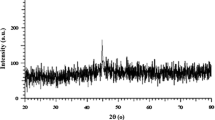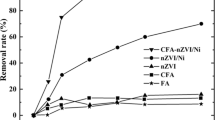Abstract
During the production of lindane (γ-HCH) large volumes of wastes containing α-, β-, and δ-HCH isomers were generated. Hexachlorocyclohexanes (HCHs) are carcinogens and teratogen compounds. Although their production and use are currently banned in most countries, many landfills and sites remain polluted by these compounds. This paper studies a promising and novel alternative for the HCH abatement: dechlorination by zero valent iron microparticles. Synthetic wastewater (0.5 mg/L of α-, β-, γ-, and δ-HCH or 6 mg/L of γ-HCH) and five types of commercial iron microparticles (here named mFe-1, mFe-2, mFe-3, mFe-4, and mFe-5) were used in batch (5 g/L) and continuous (W mFe/Q L = 167 g · h/L) operation mode at room temperature. Iron microparticles were characterized (before and after reaction) by N2 adsorption/desorption isotherms and X-ray diffraction. HCH isomers showed different behavior vs. dechlorination (γ > α > δ > β) according to the axial/equatorial position of the chlorines. The most active iron source among those tested was mFe-1, presenting small particle diameter (70 μm), moderate BET area (35 m2/kg), low oxygen content, and traces of manganese. mFe-1 exhibited high activity and stability both in continuous (X γ-HCH = 70%, W mFe/Q L = 167 g · h/L) and discontinuous (X γ-HCH = 100%, 48 h) operation. Contribution of HCH adsorption over iron microparticles was found negligible being benzene and Cl− the final dechlorination products.





Similar content being viewed by others
References
Begum, A., & Gautam, S. K. (2012). Endosulfan and lindane degradation using ozonation. Environmental Technology, 33(8), 943–949.
Buser, H. R., & Muller, M. D. (1995). Isomer and enantioselective degradation of Hexachlorocyclohexane isomers in sewage-sludge under anaerobic conditions. Environmental Science & Technology, 29(3), 664–672.
Camacho-Pérez, B., Ríos-Leal, E., Rinderknecht-Seijas, N., & Poggi-Varaldo, H. M. (2012). Enzymes involved in the biodegradation of hexachlorocyclohexane: a mini review. Journal of Environmental Management, 95, S306–S318.
Chang, C., Lian, F., & Zhu, L. (2011). Simultaneous adsorption and degradation of gamma-HCH by nZVI/Cu bimetallic nanoparticles with activated carbon support. Environmental Pollution, 159(10), 2507–2514.
Chen, Z., Cheng, Y., Chen, Z., Megharaj, M., & Naidu, R. (2012). Kaolin-supported nanoscale zero-valent iron for removing cationic dye-crystal violet in aqueous solution. Journal of Nanoparticle Research, 14(8), 899.
Cong, X., Xue, N., Wang, S., Li, K., & Li, F. (2010). Reductive dechlorination of organochlorine pesticides in soils from an abandoned manufacturing facility by zero-valent iron. Science of the Total Environment, 408(16), 3418–3423.
Dutchak, S., Shatalov, V., Mantseva, M., Rozovskaya, O., Vulykh, N., Fedyunin, M., Aas, W., Breivik, K., Mano, S. (2004). Persistent organic pollutants in the environment, status report 3. Cooperative Programme for Monitoring and Evaluation of the Long Range Transmission of Air Pollutants in Europe.
Elliott, D. W., Lien, H., & Zhang, W. (2008). Zerovalent iron nanoparticles for treatment of ground water contaminated by hexachlorocyclohexanes. Journal of Environmental Quality, 37(6), 2192–2201.
Elliott, D. W., Lien, H., & Zhang, W. (2009). Degradation of lindane by zero-valent iron nanoparticles. Journal of Environmental Engineering, 135(5), 317–324.
Environmental Protection Agency (2012a). Selected analytical methods for environmental remediation and recovery (SAM).
Environmental Protection Agency (2012b). A citizen’s guide to soil vapor extraction and air sparging.
Fu, F., Dionysiou, D. D., & Liu, H. (2014). The use of zero-valent iron for groundwater remediation and wastewater treatment: a review. Journal of Hazardous Materials, 267, 194–205.
Grittini, C., Malcomson, M., Fernando, Q., & Korte, N. (1995). Rapid dechlorination of polychlorinated-biphenyls on the surface of a Pd/Fe bimetallic system. Environmental Science & Technology, 29(11), 2898–2900.
Joo, S. H., & Zhao, D. (2008). Destruction of lindane and atrazine using stabilized iron nanoparticles under aerobic and anaerobic conditions: effects of catalyst and stabilizer. Chemosphere, 70(3), 418–425.
Lacinova, L., Cernik, M., Sourkova, H. (2013). Degradation of chlorinated cyclohexanes (lindane) by zero-valent iron nanoparticles (NZVI). Nanocon 2013, 5th International Conference, 453–455.
Liu, T., Li, X., & Waite, T. D. (2014). Depassivation of aged Fe0 by divalent cations: correlation between contaminant degradation and surface complexation constants. Environmental Science & Technology, 48(24), 14564–14571.
Lowry, G. V., & Johnson, K. M. (2004). Congener-specific dechlorination of dissolved PCBs by microscale and nanoscale zerovalent iron in a water/methanol solution. Environmental Science & Technology, 38(19), 5208–5216.
Matheson, L. J., & Tratnyek, P. G. (1994). Reductive dehalogenation of chlorinated methanes by iron metal. Environmental Science & Technology, 28(12), 2045–2053.
Mertens, B., Blothe, C., Windey, K., De Windt, W., & Verstraete, W. (2007). Biocatalytic dechlorination of lindane by nano-scale particles of Pd(0) deposited on Shewanella oneidensis. Chemosphere, 66(1), 99–105.
Morrison, R. T. and Boyd, R. N. (1987). Study guide to organic chemistry. Allyn & Bacon, 5th ed., ISBN: 0205106463.
Nagpal, V., Bokare, A. D., Chikate, R. C., Rode, C. V., & Paknikar, K. M. (2010). Reductive dechlorination of gamma-hexachlorocyclohexane using Fe-Pd bimetallic nanoparticles. Journal of Hazardous Materials, 175(1–3), 680–687.
Nienow, A. M., Bezares-Cruz, J. C., Poyer, I. C., Hua, I., & Jafvert, C. T. (2008). Hydrogen peroxide-assisted UV photodegradation of lindane. Chemosphere, 72(11), 1700–1705.
Nitoi, I., Oncescu, T., & Oancea, P. (2013). Mechanism and kinetic study for the degradation of lindane by photo-Fenton process. Journal of Industrial and Engineering Chemistry, 19(1), 305–309.
Peng, L., Deng, D., Guan, M., Fang, X., & Zhu, Q. (2015). Remediation HCHs POPs-contaminated soil by activated persulfate technologies: feasibility, impact of activation methods and mechanistic implications. Separation and Purification Technology, 150, 215–222.
Prager, J. C. (1995). Environmental contaminant reference databook volume 1. New York: Van Nostrand Reinhold. 1264 p.
San Roman, I., Alonso, M. L., Bartolome, L., Galdames, A., Goiti, E., Ocejo, M., Moragues, M., Alonso, R. M., & Vilas, J. L. (2013). Relevance study of bare and coated zero valent iron nanoparticles for lindane degradation from its by-product monitorization. Chemosphere, 93(7), 1324–1332.
Schuth, C., & Reinhard, M. (1998). Hydrodechlorination and hydrogenation of aromatic compounds over palladium on alumina in hydrogen-saturated water. Applied Catalysis B: Environmental, 18(3–4), 215–221.
Senthilnathan, J., & Philip, L. (2010). Photocatalytic degradation of lindane under UV and visible light using N-doped TiO2. Chemical Engineering Journal, 161(1), 83–92.
Silvestroni, L., & Palleschi, S. (1999). Effects of organochlorine xenobiotics of human spermatozoa. Chemosphere, 39(8), 1249–1252.
Singh, R., Singh, A., Misra, V., & Singh, R. P. (2011). Degradation of lindane contaminated soil using zero-valent iron nanoparticles. Journal of Biomedical Nanotechnology, 7(1), 175–176.
Singh, R., Misra, V., Mudiam, M. K. R., Chauhan, L. K. S., & Singh, R. P. (2012). Degradation of gamma-HCH spiked soil using stabilized Pd/Fe-0 bimetallic nanoparticles: pathways, kinetics and effect of reaction conditions. Journal of Hazardous Materials, 237, 355–364.
Usman, M., Tascone, O., Faure, P., & Hanna, K. (2014). Chemical oxidation of hexachlorocyclohexanes (HCHs) in contaminated soils. Science of the Total Environment, 476, 434–439.
Vikelsoe, J., & Johansen, E. (2000). Estimation of dioxin emission from fires in chemicals. Chemosphere, 40(2), 165–175.
Wacławek, S., Antoš, V., Hrabák, P., Černík, M., & Elliott, D. (2016). Remediation of hexachlorocyclohexanes by electrochemically activated persulfates. Environmental Science and Pollution Research, 23(1), 765–773.
Walker, K., Vallero, D. A., & Lewis, R. G. (1999). Factors influencing the distribution of lindane and other hexachlorocyclohexanes in the environment. Environmental Science & Technology, 33(24), 4373–4378.
Wang, Z., Peng, P., & Huang, W. (2009). Dechlorination of gamma-hexachlorocyclohexane by zero-valent metallic iron. Journal of Hazardous Materials, 166(2–3), 992–997.
World Health Organization. (1991). Environment health criteria 124: lindane. International Programme on Chemical Safety, WHO EHC.
Yang, J., & Sun, H. (2015). Degradation of γ-hexachlorocyclohexane using carboxymethylcellulose-stabilized Fe/Ni nanoparticles. Water, Air, & Soil Pollution, 226(9), 1–15.
Yang, S., Lei, M., Chen, T., Li, X., Liang, Q., & Ma, C. (2010). Application of zerovalent iron (Fe0) to enhance degradation of HCHs and DDX in soil from a former organochlorine pesticides manufacturing plant. Chemosphere, 79(7), 727–732.
Zhang, W. X. (2003). Nanoscale iron particles for environmental remediation: an overview. Journal of Nanoparticle Research, 5(3–4), 323–332.
Zinovyev, S. S., Shinkova, N. A., Perosa, A., & Tundo, P. (2004). Dechlorination of lindane in the multiphase catalytic reduction system with Pd/C, Pt/C and Raney-Ni. Applied Catalysis B: Environmental, 47(1), 27–36.
Acknowledgements
The authors acknowledge the financial support from the Comunidad Autonoma of Madrid (Project S2013-MAE-2739 CARESOIL-CM) and from the Spanish Ministry of Economy and Competitiveness (Project CTM2013-43794-R). CMD acknowledges the Spanish MICINN for “Juan de la Cierva” post doctoral grant (FJCI-2014-20732).
Author information
Authors and Affiliations
Corresponding author
Rights and permissions
About this article
Cite this article
Dominguez, C.M., Rodriguez, S., Lorenzo, D. et al. Degradation of Hexachlorocyclohexanes (HCHs) by Stable Zero Valent Iron (ZVI) Microparticles. Water Air Soil Pollut 227, 446 (2016). https://doi.org/10.1007/s11270-016-3149-8
Received:
Accepted:
Published:
DOI: https://doi.org/10.1007/s11270-016-3149-8




